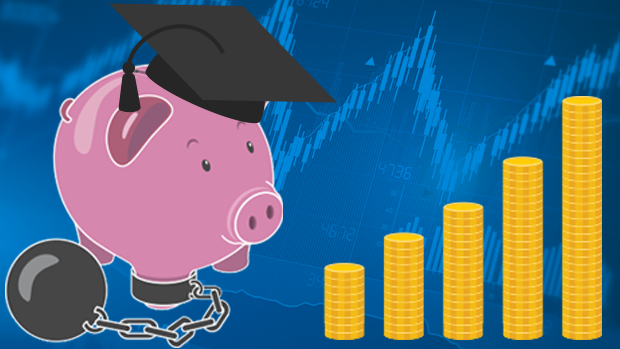May 3, 2018
How to invest for the future, even while shackled by student debt

A modern-day financial Houdini, Jordann Brown knows a thing or two about swiftly escaping the shackles of student indebtedness with no key in sight.
Brown, now a personal finance writer and millennials-and-money expert, was 21 when her $42,000 student-loan bill arrived after graduating with a Bachelor of Commerce degree from Dalhousie University in 2011. With hard work and a few tricks up her sleeve, she paid off that debt in just 24 months (she chronicles her journey out of debt, with tips, in depth on her blog).
While Brown’s savviness is atypical, the financial burden she faced after graduating isn’t. Many young Canadians face a challenging balancing act on how to invest in their future, while also contending with present-day expenses — which, in many cases, involves a sizeable student debt.
The pressure to pay off that debt sooner is amplified by rising interest rates. The Bank of Canada has increased its benchmark lending rate three times since last summer from rock-bottom lows, increasing the cost of a student loan.
“You should pay it off now when [interest rates] are low. I don’t think you should wait until the interest rate is higher and it’s a problem and then focus on paying off your debt,” Brown said.
“You should focus on it now when every payment that you make is going to make a bigger dent on the principal because the interest rate is lower.”
While there’s no one-size-fits-all solution, one course of action is to invest and pay down your student-loan debt at the same time so that, ideally, you can use the returns on your investments to help chip away at that balance.
“You’re generally trying to kill two birds with one stone,” said Dan Noonan, investment advisor at Argosy Securities. “People often do do one or the other, and I would say it’s not the proper way.”
Below are some words of wisdom from Brown and Noonan on how — and when — to start investing for the future, even if you feel like you’re bound by a straightjacket and drowning in debt from government-issued student loans right now.
AGE IS A FACTOR
Although it’s not possible for everyone, Noonan suggests starting an investment plan no later than the age of 25.
“You want to maximize time. Everybody hears about the magic of compounding, but that does not work without time,” Noonan said.
He suggests allocating 10 per cent of your income towards investments — but the later you start, the more income you’ll have to allocate down the road in order to build enough wealth for retirement.
“If I’m 25, I can successfully build a retirement plan using 10 per cent. If I’m 35, now it’s up to 18 per cent. If I’m 45, I have to save about 25 per cent,” Noonan said.
Noonan said that before hitting 25, it’s best to focus on getting as much of that student debt out of the way as possible, if not all of it.
That’s what Brown did. She says it was easy to focus strictly on paying off her student debt before she made her foray into investing.
But she acknowledges that that’s not realistic for everyone. Whether you should start investing with student debt on your hands depends on how long you think it’ll take you to clear the balance.
“Anything longer than two years, you should really think about adopting a balanced approach because two years is a long time to stringently focus on a single goal,” Brown said.
NO SINGLE ‘CORRECT’ PRODUCT
There’s no one investment vehicle that works best for everyone, but Noonan said he is a proponent of investing in equities in an RRSP.
“You should be able to make six to eight per cent on an RRSP investment program. So you’re neutral in that you’re getting a tax break on your RRSP contribution, so that’s more than covering the interest cost on the loan,” Noonan said.
Investing in an RRSP will also result in tax credits which, Noonan suggests, you can put towards your student loan.
However, Brown said that for those just starting out, the amount one saves is ultimately more crucial than where the money goes.
“If you have a much larger portfolio, yes, a few percentage points is going to make a big difference. Right now, you need to just start,” Brown said.
KNOW YOUR GOALS
A big mistake is pulling the money out of your RRSP or another long-term savings vehicle too early to fund another goal, Noonan said.
He gives the example of using retirement savings for making a down payment on a home.
“The money is supposed to be in the retirement program, it’s not a housing program,” he said.
Brown didn’t abide by this rule when she bought a house in Halifax back in 2016. She borrowed $4,000 from her RRSP via the Home Buyers’ Plan, which allows first-time buyers to withdraw up to $25,000 from their RRSP. The buyer has 15 years to pay back what they borrow; if they don’t, the amount is considered taxable income.
Brown said she was “hyperaware” of this risk, so she made it a point to pay back what she borrowed as soon as possible.
“Once [my husband and I] moved into the house, my number one goal was to pay that money back, and I paid it back within a few months.”









